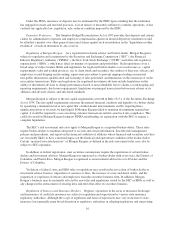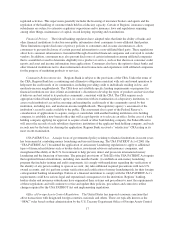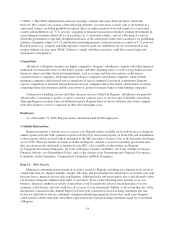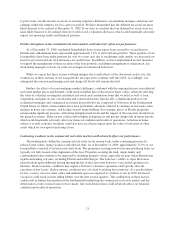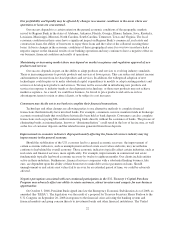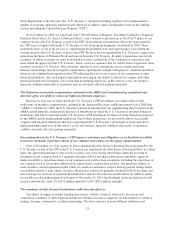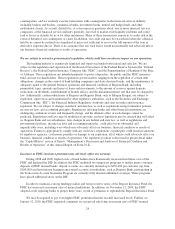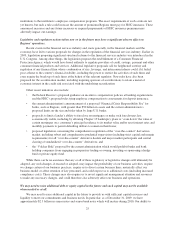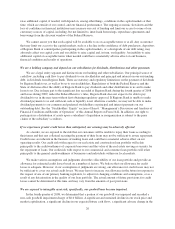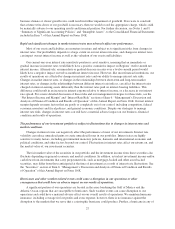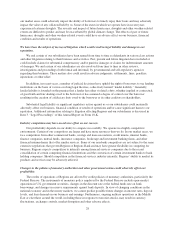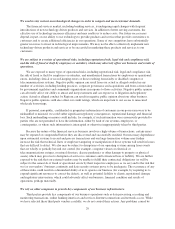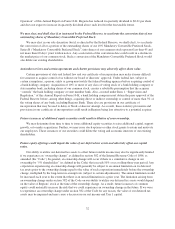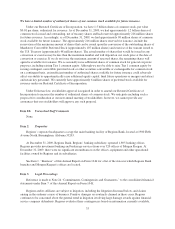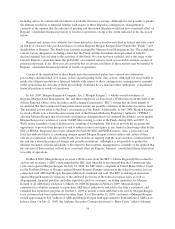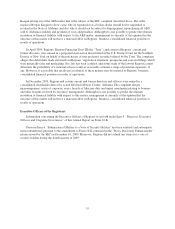Regions Bank 2009 Annual Report Download - page 39
Download and view the complete annual report
Please find page 39 of the 2009 Regions Bank annual report below. You can navigate through the pages in the report by either clicking on the pages listed below, or by using the keyword search tool below to find specific information within the annual report.institutions to the institution’s employee compensation programs. The exact requirements of such a rule are not
yet known, but such a rule could increase the amount of premiums Regions must pay for FDIC insurance. These
announced increases and any future increases or required prepayments of FDIC insurance premiums may
adversely impact our earnings.
Legislative and regulatory actions taken now or in the future may have a significant adverse effect on
Regions’ operations.
Recent events in the financial services industry and, more generally, in the financial markets and the
economy, have led to various proposals for changes in the regulation of the financial services industry. Earlier in
2009, legislation proposing significant structural reforms to the financial services industry was introduced in the
U.S. Congress. Among other things, the legislation proposes the establishment of a Consumer Financial
Protection Agency, which would have broad authority to regulate providers of credit, savings, payment and other
consumer financial products and services. Additional legislative proposals call for heightened scrutiny and
regulation of any financial firm whose combination of size, leverage, and interconnectedness could, if it failed,
pose a threat to the country’s financial stability, including the power to restrict the activities of such firms and
even require the break-up of such firms at the behest of the relevant regulator. New rules have also been
proposed for the securitization market, including requiring sponsors of securitizations to retain a material
economic interest in the credit risk associated with the underlying securitization.
Other recent initiatives also include:
• the Federal Reserve’s proposed guidance on incentive compensation policies at banking organizations
and the FDIC’s proposed rules tying employee compensation to assessments for deposit insurance;
• the current administration’s announcement of a proposed “Financial Crisis Responsibility Fee” for
banks, such as Regions, with greater than $50 billion in assets and the current administration’s
proposed limits on the size and risks taken by large U.S. banks;
• proposals to limit a lender’s ability to foreclose on mortgages or make such foreclosures less
economically viable, including by allowing Chapter 13 bankruptcy plans to “cram down” the value of
certain mortgages on a consumer’s principal residence to its market value and/or reset interest rates and
monthly payments to permit defaulting debtors to remain in their home;
• proposed legislation concerning the comprehensive regulation of the “over-the-counter” derivatives
market, including robust and comprehensive prudential supervision (including strict capital and margin
requirements) for all “over-the-counter” derivative dealers and major market participants and central
clearing of standardized “over-the-counter” derivatives; and
• the “Volcker Rule” proposed by the current administration which would prohibit banks and bank
holding companies from engaging in proprietary trading or owning, investing or sponsoring a hedge
fund or private equity fund.
While there can be no assurance that any or all of these regulatory or legislative changes will ultimately be
adopted, any such changes, if enacted or adopted, may impact the profitability of our business activities, require
we change certain of our business practices, require us to divest certain business lines, materially affect our
business model or affect retention of key personnel, and could expose us to additional costs (including increased
compliance costs). These changes may also require us to invest significant management attention and resources
to make any necessary changes, and could therefore also adversely affect our business and operations.
We may need to raise additional debt or equity capital in the future and such capital may not be available
when needed or at all.
We may need to raise additional capital in the future to provide us with sufficient capital resources and
liquidity to meet our commitments and business needs. In particular, as of December 31, 2009, we have
approximately $2.3 billion in senior notes and senior bank notes which will mature during 2010. Our ability to
25



